Top 9 Choices for 9 Eco Friendly Flooring Options
Picking the right floor doesn’t have to be a headache. Nowadays, you can get tough stuff, looks good and won’t trash the planet. From bamboo to polished concrete and recycled materials, there are plenty of chill, Eco-Friendly Options that work for homes or businesses.
Bamboo Flooring: Fast-Growing, Eco-Friendly, and Great for Modern Spaces
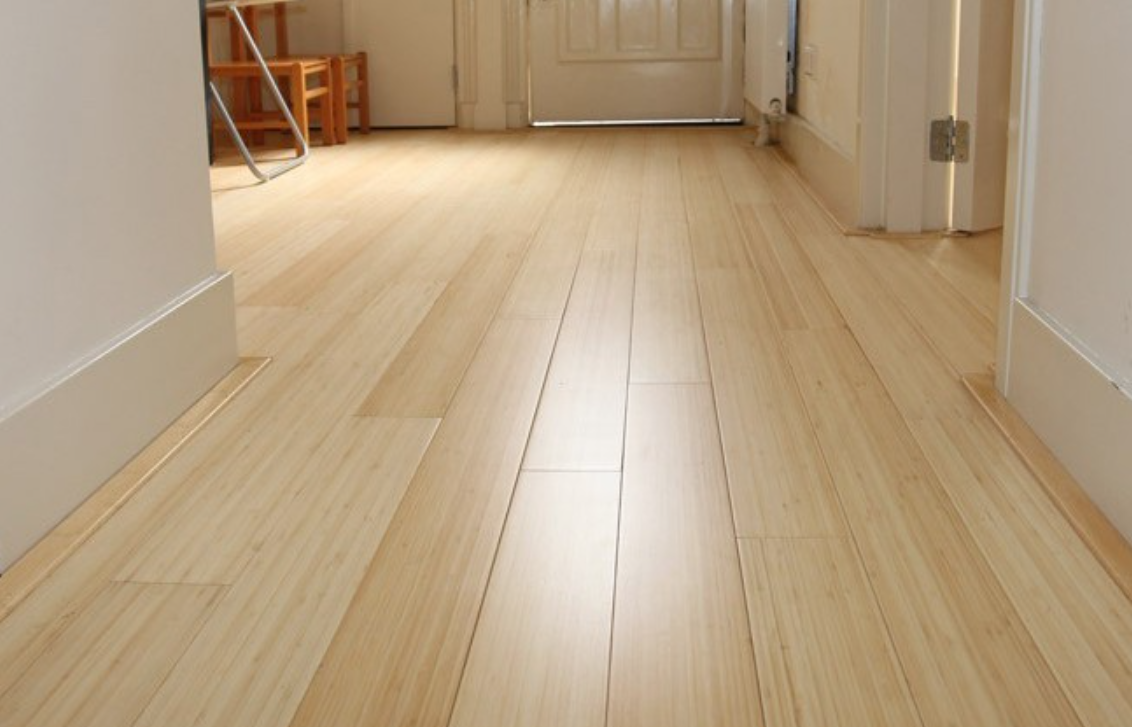
Bamboo flooring is a great choice because it’s strong, long-lasting, and good for the environment. I’ve seen it work well in both homes and businesses. What’s really impressive is strand woven bamboo. It’s more than twice as hard as oak, and some tests show it’s even stronger than steel. This makes it my top recommendation for busy places. It holds up well in offices, gyms, museums, yoga studios, restaurants, shops, hotels, and airports.
Sustainability and Environmental Certifications
One reason I like bamboo is that it’s a sustainable material. It’s a type of grass that grows back quickly. You can harvest it every 3–5 years, while hardwood trees can take decades to mature. I always recommend you look for floors with certifications like FloorScore. This proves the product has low emissions and came from responsible sources.
Pros and Cons of Bamboo Flooring
Pros: Bamboo’s solid. Good quality stuff lasts years—easily over a decade. So you’re not swapping it out all the time. Less hassle, less waste. Super low maintenance. Just sweep, vacuum, and a light mop lightly now and then. It doesn’t hold odors, and bugs don’t like it. Lots of design options too. Light tones, dark tones, modern, classic—whatever the space needs, there’s something that fits. Looks clean, adds value. Clients like the finish. Price point’s great too. Usually around two to eight bucks a square foot. Not bad for something that feels premium.
Cons: Cheaper bamboo? Kinda soft. It can scratch or dent if you’re not careful. Not ideal for heavy traffic with no protection. And if humidity jumps around a lot—no climate control—it might crack. Pretty much the same issue as natural wood. So yeah, just depends on the environment.
Potential Emissions: Some products use glues that contain formaldehyde. I strongly advise you to choose options with certifications for low emissions to ensure your air quality is safe.
Cork Flooring: Soft, Quiet, and Naturally Sustainable
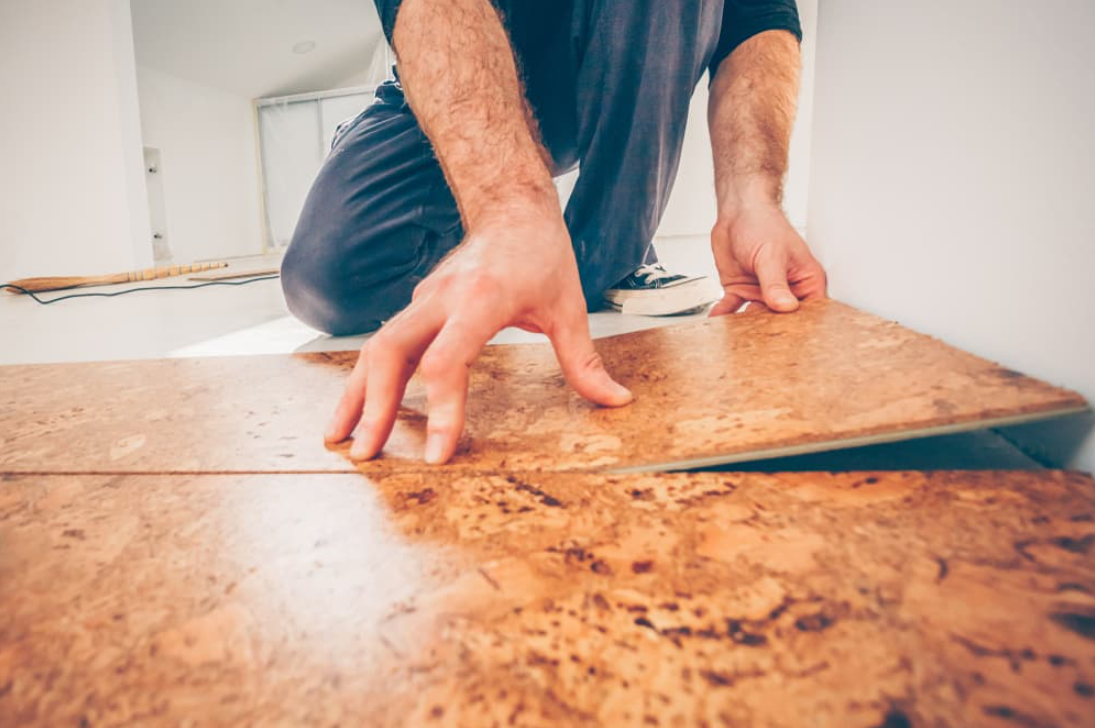
Cork flooring is exactly choice as an earth-friendly option for homes and businesses. People love it for more than just its green qualities. From my experience, it’s also comfortable, quiet, and good for your health.
Sustainability and Green Credentials
Cork comes from the bark of cork oak trees, and it’s a renewable material. Harvesting the bark doesn’t hurt the trees. They keep growing and taking in carbon dioxide. You can harvest the bark every 9–12 years without issue. This regrowth process makes cork production carbon negative, which I find is a huge benefit for the planet. Cork is also biodegradable. It’s often made with few volatile organic compounds (VOCs), which means cleaner indoor air.
Real Benefits of Cork Flooring
Cork floors last a long time—think 30, 40 years if you keep ‘em clean. You can sand and refinish them to make them look fresh again. They don’t hold smells or bugs, which is great if you or your clients care about allergies.
They’re comfy to stand on—soft and bouncy, perfect for kitchens or gyms. Plus, cork soaks up sound, so places stay quiet. You’ll see it in schools and studios for that reason.
Every floor’s got its own look, and you can change the color to match any style. It’s fire-resistant too and easy to keep up.
All in all, cork’s a smart pick if you want something comfy, healthy, and built to last.
Linoleum Flooring: Green, Strong, and Flexible
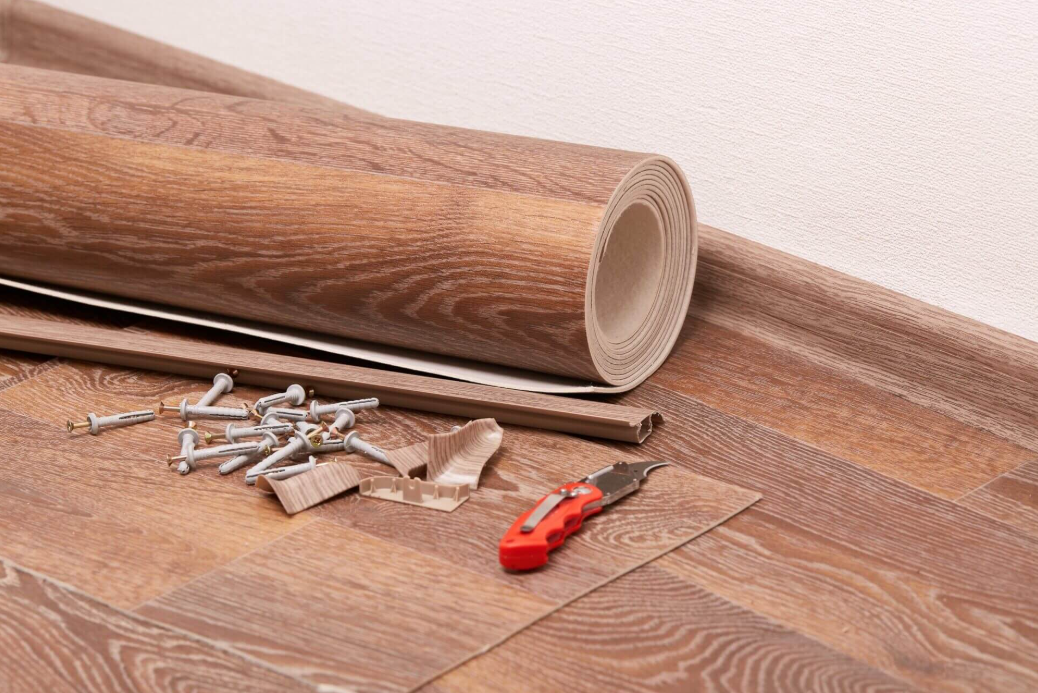
Linoleum is a top choice if you want green flooring. It’s made from 100% natural materials, mostly linseed oil, cork dust, wood flour, resins, and a jute backing. All its parts are biodegradable and can be recycled. When its long life is over, linoleum breaks down on its own. This is much better for the earth than synthetic floors that just create landfill waste.
Why Linoleum Works
Linoleum can last up to 40 years if you take care of it right. It handles scratches, dents, scuffs, and water, especially when sealed by a pro. Perfect for busy spots like entrances, halls, kitchens, and bathrooms.
It fights bacteria and mold, so it’s a solid choice for places that need top hygiene—think hospitals, schools, and healthcare facilities.
Maintenance is easy. Just sweep and damp mop—no fancy cleaners needed. Plus, it won’t mess with your indoor air quality since it doesn’t release harmful chemicals.
Bottom line: Linoleum’s a balanced, eco-friendly, safe, and cost-effective flooring. I’ve seen it perform well pretty much anywhere, from hospitals to homes.
Recycled Rubber Flooring: Tough, Green, and Built for Heavy Use

Recycled rubber flooring comes from used rubber, mainly from old tires. This makes it a great sustainable and eco-friendly choice. It cuts down on landfill waste and has a much lower environmental impact than other floors.
Why Recycled Rubber Flooring Rocks
This flooring handles heavy foot traffic like a champ. Perfect for busy spots—gyms, schools, stores. Gyms love it for shock absorption, and schools for safer play areas.
It cuts down noise big time. Great for open offices and hallways where quiet matters.
Slip-resistant and water-proof, even when wet. Awesome for places like restaurants and hospitals where spills happen.
Super easy to clean—just a damp mop. Resists scratches and scuffs, so it lasts long without needing replacement.
It’s eco-friendly too—100% PVC-free and low VOCs, which means better air quality and a smaller carbon footprint.
Fire-safe, meeting tough standards, so it works well in commercial buildings.
Plus, it’s comfy to stand on all day and helps reduce fatigue and injuries.
Design-wise, tons of colors and patterns. Some vendors even do custom colors or logos, perfect for branding.
The Sustainability and Versatility Advantage
When you choose recycled rubber flooring, you support a circular economy. You help cut down on waste and create healthier indoor air. You also get a floor that performs well, is safe, and looks great. For me, these reasons make it a top choice. I recommend it for environmentally friendly homes and for tough commercial jobs.
Polished Concrete Flooring: Sustainable, High-Performance Finish
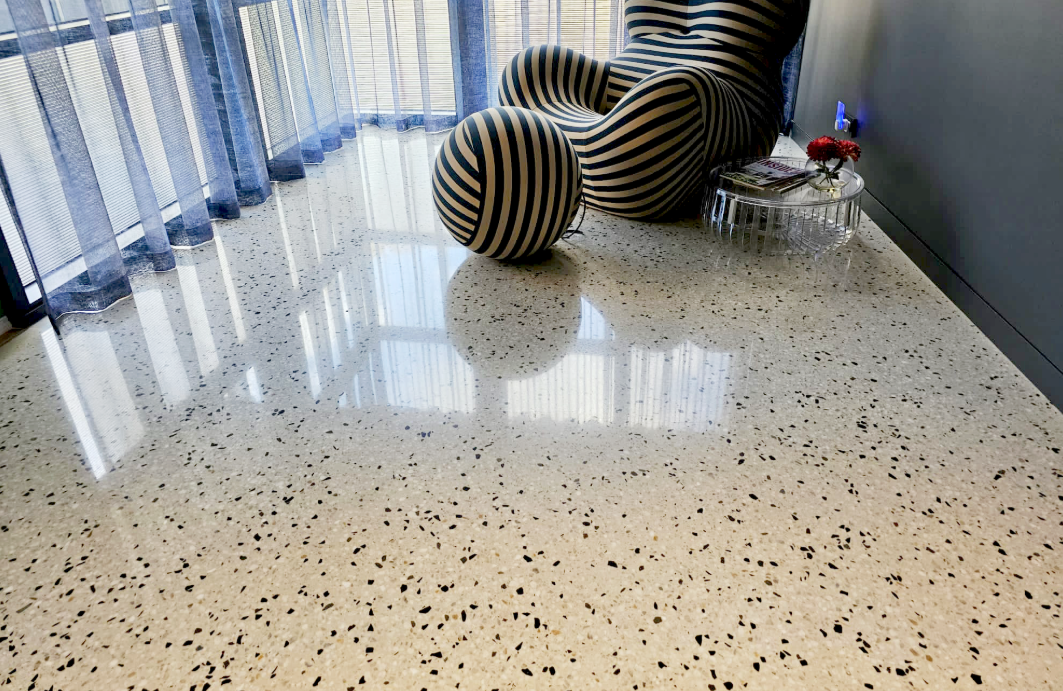
Polished concrete for flooring in commercial and residential projects, I believe it’s a top choice because it’s green, tough, and energy-efficient, setting it apart from other flooring options.
Environmental Benefits of Polished Concrete
Polished concrete’s smart because it uses what’s already there — the building’s slab. No need to slap on new tiles or carpet and waste a bunch of stuff. Plus, they mix in crushed old concrete sometimes, so less digging up new rocks and less trash piling up. It’s like giving old materials a second life. And bonus — this kind of setup can help you snag those green building creds. So yeah, it’s easy on the wallet and easy on the planet.
Low Chemical Emissions: The process for polishing concrete releases almost no harmful chemicals, known as volatile organic compounds (VOCs). This is key for keeping indoor air clean. I find this benefit vital for hospitals, schools, and any place where health is a top priority and needs to meet LEED standards.
Why I Always Recommend Polished Concrete for Commercial Projects
I’ve been in this flooring work for a long time, and polished concrete is legit tough. Takes minimal upkeep and can easily last 20 years or more. You won’t be tearing it out anytime soon, which saves you big on replacement costs and headaches. It handles heavy foot traffic and equipment like a beast — perfect for warehouses, shops, and offices.
The greatest thing is that the shiny surface bounces natural light around, so you cut your electric bills by up to 30%. Brighter spaces mean happier, safer workers.
From an eco angle, it’s smart too. You’re reusing the building’s slab, so less waste, less new materials, and your carbon footprint shrinks. Plus, it helps you nail those green building certifications clients want.
Recycled Glass Tile: Stylish, Sustainable, and Built to Shine
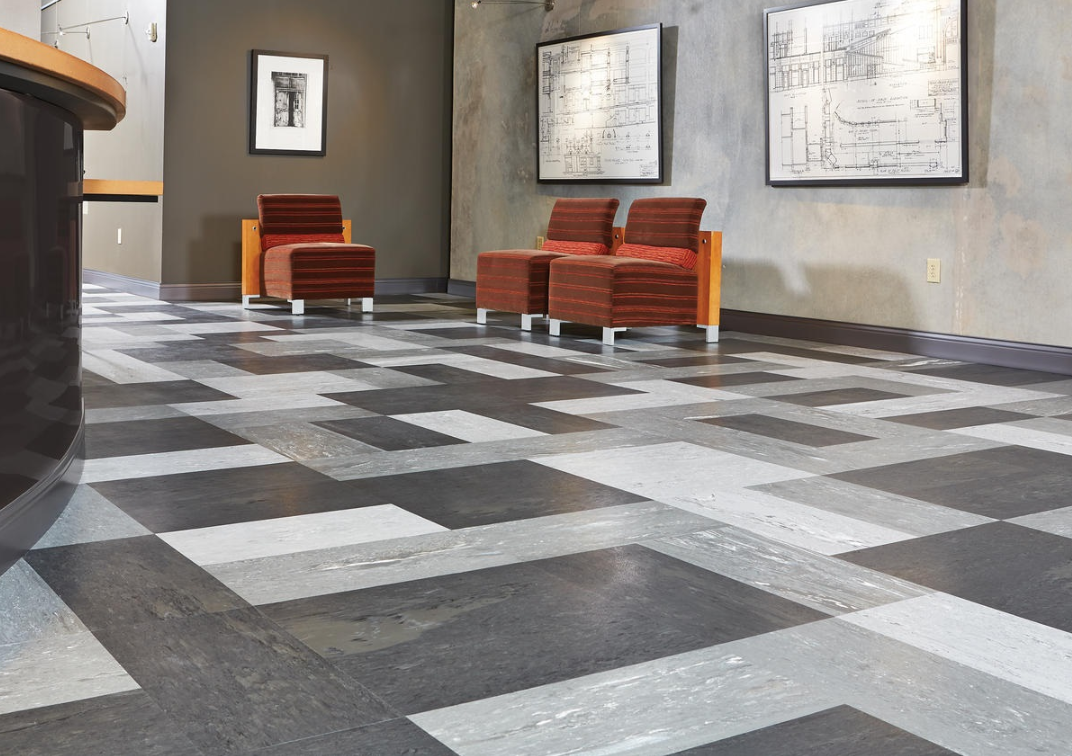
Recycled glass tile is a beautiful and sustainable choice for floors and walls. I have seen it work well in homes and businesses. The tiles are made from used glass, which is great for the environment and gives you a lot of design freedom.
Versatile Applications
This tile can be used almost anywhere. It looks great in kitchens, bathrooms, showers, pools, and even hotel lobbies.
It’s resistant to water and moisture. This makes it a great choice for wet areas like shower floors or around a pool.
You can install it on floors and walls. Some types, like porcelain with a recycled glass top, are tough enough for both indoor and outdoor use.
Pros of Recycled Glass Tile
Look, recycled glass tile is honestly pretty solid. It’s tough and easy to clean, so it holds up no matter how much foot traffic or mess you throw at it. Perfect for spots that get used a lot, like kitchens or stores. A lot of them don’t get slippery, which is clutch for bathrooms or pool areas. And it’s good for the planet ‘cause it’s made from stuff that would’ve been trash otherwise. You can slap it on floors or walls, and there’s tons of colors and styles, so you won’t be stuck with boring floors. It handles water and stains like a champ and wears well over time. All in all, it looks good, lasts long, and is an easy way to go green.
Recycled Carpet Tiles: Smart, Sustainable Flooring for High-Traffic Spaces
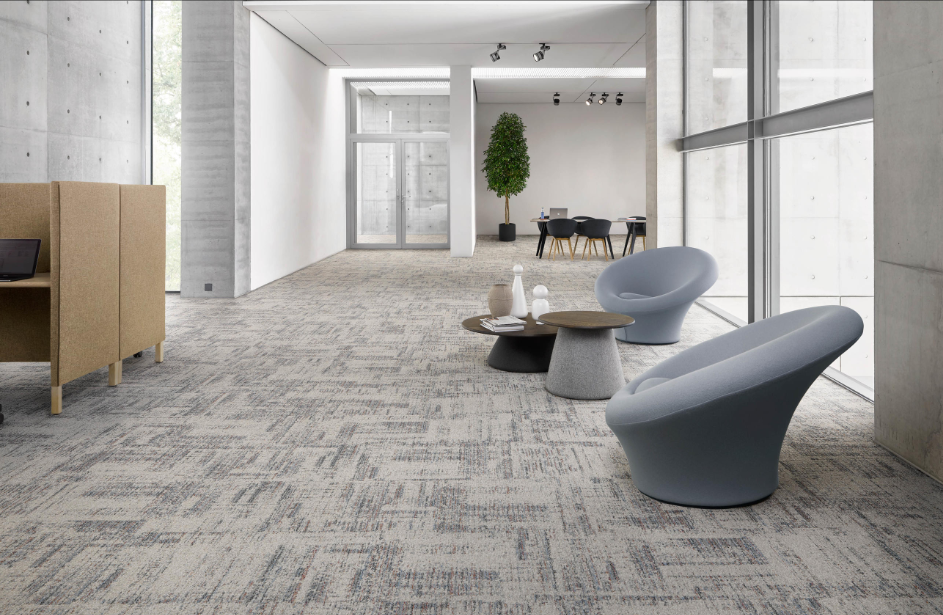
Recycled carpet tiles are a top green flooring choice. They work well for both homes and businesses. You get sustainability and high performance in one product.
Circular Sustainability and Environmental Impact
I’ve seen some collections, like DESSO Futurity, use 100% recycled yarn. Their total recycled and bio-based content is 69%.
Some product lines are completely recyclable. Manufacturers produce them with a small carbon footprint, as low as 0.78 kg CO₂/m².
Manufacturers are also improving their recycling methods. They are testing ways to separate the textile from the backing. This would allow them to reclaim and reuse every part of an old tile.
Where Recycled Carpet Tiles Work Best
These tiles are perfect for busy places. This includes high-traffic commercial buildings, schools, offices, and even in homes.
I recommend them because they are durable and easy to maintain. They also contribute positively to green building standards.
Based on my experience, recycled carpet tiles offer a great mix of sustainability, modular design, comfort, and green certification. I believe they are a smart, forward-thinking choice for any project that cares about performance and the environment.
Luxury Vinyl Tile (LVT) and Plank (LVP) with Recycled Content
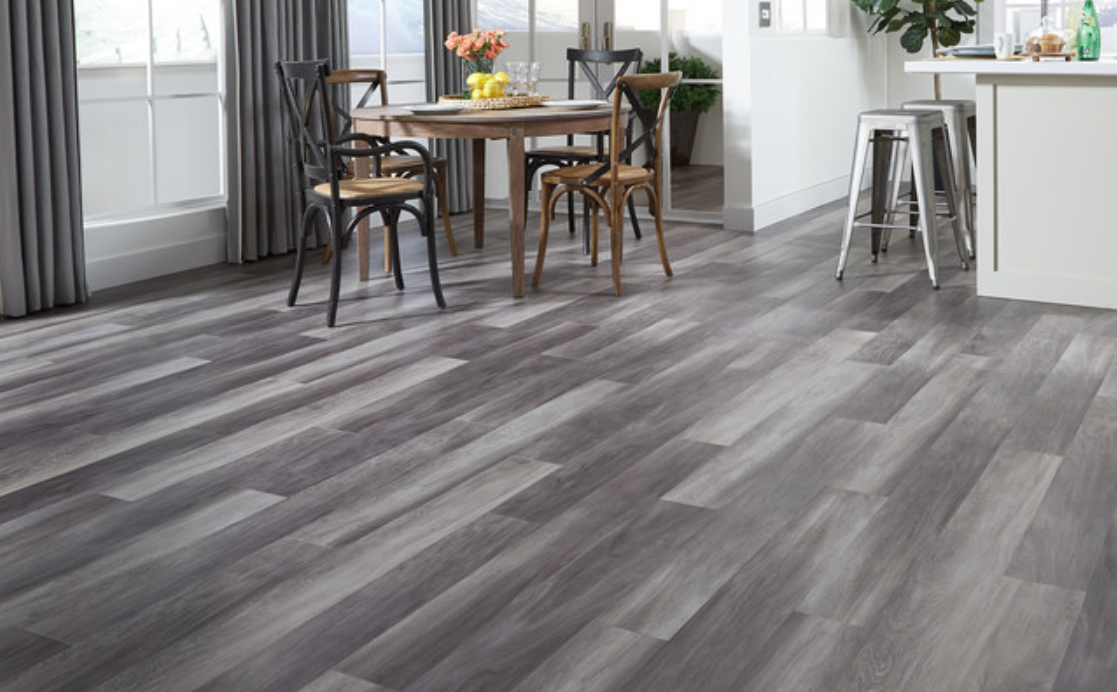
Luxury Vinyl Tile (LVT) and Luxury Vinyl Plank (LVP) are top choices for green flooring. I see them used in both commercial and home projects. I often recommend them because they offer a good mix of style, toughness, and eco-friendly features.
Recycled Content and Environmental Standards
Many quality LVT and LVP products contain at least 35% recycled content. Manufacturers list the recycled percentage for each product. This makes it simple to compare your options and choose a sustainable floor.
I’ve found these products are great for meeting green building certification requirements. They are a solid choice for any project focused on reducing its environmental impact.
Certifications and Health Standards
For a healthy indoor space, I look for floors with indoor air quality certifications. These products also emit low levels of VOCs. They meet strict standards, including ASTM F3261 for solid core products and ASTM F1700 for solid vinyl tile.
Most are phthalate-free, and many achieve Class A/B fire ratings.
I suggest checking the Environmental Product Declarations (EPDs). They openly report the recycled content and other green features.
Design Range and Versatility
LVT/LVP floors are available in many sizes and formats, from 6″ x 48″ planks to 12″–36″ square tiles.
Many products have advanced urethane wear layers. You can choose options like ceramic bead or aluminum oxide finishes. I find these finishes offer great scratch resistance and are easy to clean.
There is a huge selection of colors, wood-look patterns, and textures. This variety makes it simple to find a match for any design style or brand.
LVT and LVP with recycled content are a smart solution. They combine sustainability with tough performance and great style. If your project needs to be eco-friendly but you don’t want to compromise on looks or durability, I strongly recommend these floors.
Broadcast (Recycled Content Epoxy or Resinous) Flooring
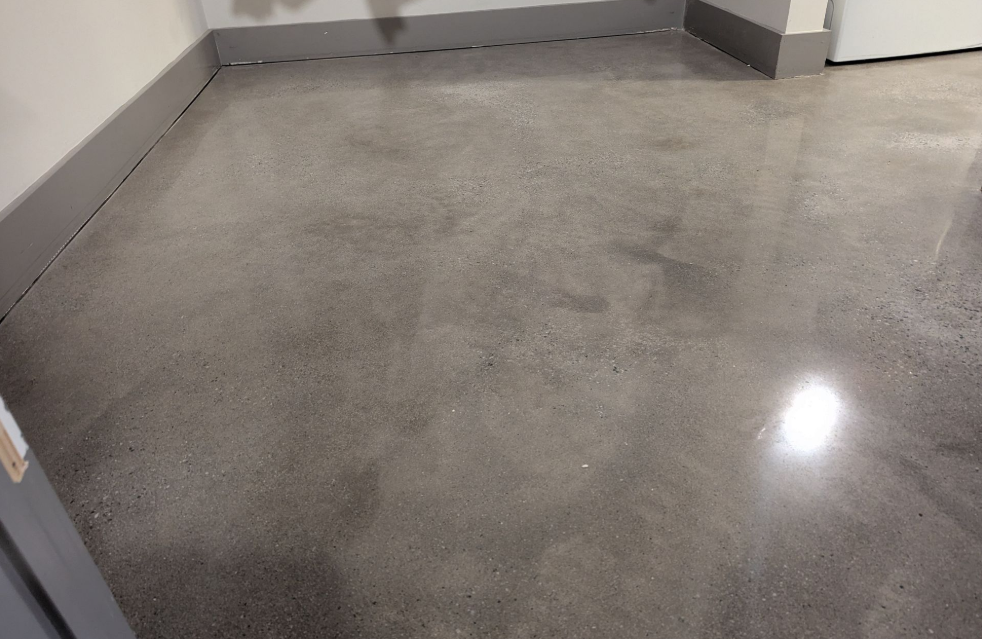
Flooring made with recycled epoxy is a great choice for green building projects. Based on my experience, these seamless floors are very durable, safe, and offer many design options. They also help you get green building certifications for your home or business.
Sustainability and Certification
Recycled Content Documentation: Manufacturers provide paperwork showing the amount of postconsumer and preconsumer recycled material used by weight. This documentation helps you earn LEED credits, like MR 4.1/4.2 and IEQ 4.2.
Low-VOC and Solvent-Free: Every layer has very low VOCs. They meet EPA Method 24 and 40 CFR 59, Subpart D regulations.
Fire Safety: The flooring is tested for fire safety. It is rated as self-extinguishing and meets the ASTM-D-635-72 standard, with a burn rate ≤ 0.25 in/min.
Manufacturer and Installer Standards: I suggest you use certified contractors for this job. They should have at least three years of experience. The manufacturers should also have a five-year history. This ensures you get a quality installation that meets all standards.
Prices for professional installation and materials will depend on your location and the system’s thickness. They usually start around $7–$15 per square foot for certified, commercial-grade floors.
My Evaluation
Broadcast floors with recycled content are a smart investment for a sustainable project. They are extremely durable, very hygienic, proven to be safe, and come with green certifications. If you want a floor that can handle heavy use and is simple to maintain, this is a fantastic choice. It meets today’s highest environmental standards, and I think it’s one of the best options you can find.
Bottom Line on Green Flooring: Lasting Value and Low Impact
You don’t have to choose between style, durability, and being green. These floors hold up, look fresh, and help keep things sustainable. Whether it’s bamboo’s strength or recycled rubber’s comfort, you’re making a smart call for your space and the planet. Easy win all around.
